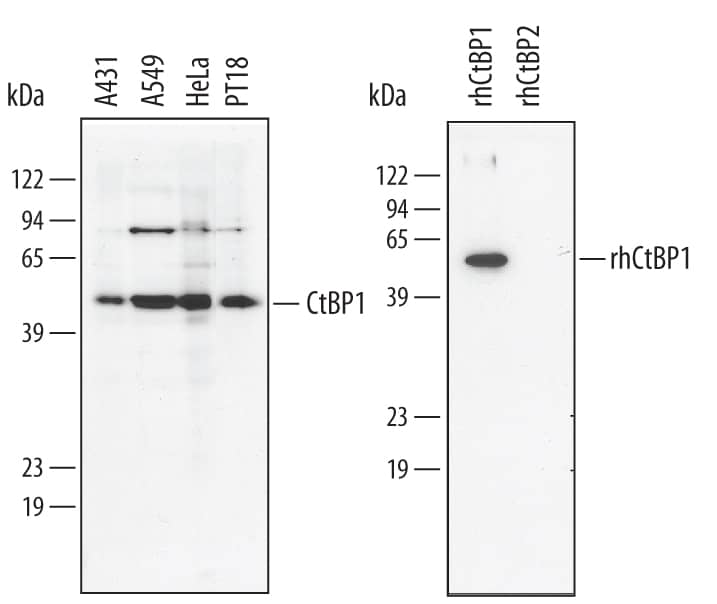Human CtBP1 Antibody
R&D Systems, part of Bio-Techne | Catalog # AF4639

Key Product Details
Species Reactivity
Applications
Label
Antibody Source
Product Specifications
Immunogen
Met1-Leu440
Accession # Q13363
Specificity
Clonality
Host
Isotype
Scientific Data Images for Human CtBP1 Antibody
Detection of Human CtBP1 by Western Blot.
Western blot shows lysates of A431 human epithelial carcinoma cell line, A549 human lung carcinoma cell line, HeLa human cervical epithelial carcinoma cell line, and PT18 mouse mast/basophil cell line. PVDF membrane was probed with 1 µg/mL Goat Anti-Human CtBP1 Antigen Affinity-purified Polyclonal Antibody (Catalog # AF4639) followed by HRP-conjugated Anti-Goat IgG Secondary Antibody (Catalog # HAF109). For additional reference, recombinant human CtBP1 and CtBP2 (5 ng/lane) were included. A specific band for CtBP1 was detected at approximately 48 kDa (as indicated). This experiment was conducted under reducing conditions and using Immunoblot Buffer Group 1.Applications for Human CtBP1 Antibody
Western Blot
Sample: A431 human epithelial carcinoma cell line, A549 human lung carcinoma cell line, HeLa human cervical epithelial carcinoma cell line, and PT18 mouse mast/basophil cell line
Formulation, Preparation, and Storage
Purification
Reconstitution
Formulation
Shipping
Stability & Storage
- 12 months from date of receipt, -20 to -70 °C as supplied.
- 1 month, 2 to 8 °C under sterile conditions after reconstitution.
- 6 months, -20 to -70 °C under sterile conditions after reconstitution.
Background: CtBP1
CtBP1 (C terminal binding protein 1) was originally identified through its binding to the Adenovirus E1A oncoprotein via a 5 amino acid motif, PLDLS, which repressed E1A induced oncogenesis and cellular transformation. In the nucleus, CtBP1 functions predominantly as a transcriptional corepressor in conjunction with a variety of DNA binding repressors.Interaction with Pnn/DRS may modulate repression of E-cadherin by CtBP1. Recruitment of CtBP1 and HDAC to Smad1/Smad4 complexes by Smad6 results in inhibition of BMP stimulated gene expression. The interaction of CtBP1 with polycomb group proteins suggests it is a component of the chromatin remodeling machinery and transcriptional repression. Cytosolic CtBP1 has also been shown to be involved with CNS synapses, membrane trafficking, and regulation of the microtubule cytoskeleton.
Long Name
Alternate Names
Gene Symbol
UniProt
Additional CtBP1 Products
Product Documents for Human CtBP1 Antibody
Product Specific Notices for Human CtBP1 Antibody
For research use only
